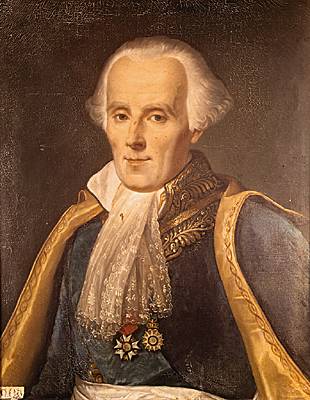Pierre Laplace
The Life and Scientific Achievement of Pierre Laplace, compiled by Jeremiah Johnson
Personal Life
Pierre Laplace was born on the March 23, 1749 to a man also named Pierre Laplace, and a woman by the name of Marie-Anne Sochon in Beaumont-en-Auge, Normandy. His family was involved in agriculture, and his father also worked as a cider merchant and town syndic. His education began at a small village school from which he gained a foundation in education that was furthered at the University of Caen, where he began studying theology at the age of 16. He branched out from theology when he was mentored by Christophe Gadbled and Pierre Le Canu, two mathematics professors at the University. He was very fond of mathematical study and his excellence in the field was noticed quickly. He soon determined that his future did not lie in theology or priesthood, so he became a full-time mathematician as his profession. He left the University of Caen and traveled to Paris with intent of studying under a supreme scientist of that day by the name of Jean le Rond d'Alembert, carrying recommendation from his prior mentor Le Canu. He impressed d'Alembert repeatedly with outstanding mathematical understanding, and he was soon giving a teaching job where he secured an income allowing him to put time into research. In this time, from 1771-1787, he produced much of his scientific work, particularly in Astronomy. In 1788, he married a girl by the name of Marie-Charlotte de Courty de Romanges who was 18, which was less than half of his 39 years of age, and they had a son and daughter soon after as well. Before his death in Paris in 1827, Laplace had earned the reputation of a renowned mathematician, astronomer, and physicist, best known for his studies in the stability of the solar system and mechanics of the universe.
Contributions to Science
Laplace began his scientific works by delving off into the field of Astronomy and Celestial Mechanics. He studied works from Sir Isaac Newton, and looked through his laws of motion and universal gravitation to make his own theories about the function of the universe, and then went on to author many works instrumental in the determining of the laws of gravitation and universe stability. While studying the stability and predictability of the solar system, he wrote much on Spherical Harmonics and what was then called Laplace Coefficients. He proceeded to use his mathematical skills to tie in scalar potential to calculus using a differential equation and simplifying vectors to define things for the first time in a mathematical physics. He continued on in his studies to discuss planetary inequalities and the notable differences between Jupiter and Saturn, as well as discussing lunar inequalities. During Laplace's time spent studying the Solar System, significant strides were made in explaining the great confusion scientists had before to how the many celestial bodies interacted. Another notable scientist of that era, Jean-Baptiste Biot, who assisted Laplace when hew as trying to fix his work to be more press-friendly, noted that occasionally when he was re-working his solutions to these problems with Universe he would even have trouble retracing his steps and reaching the same conclusions. He would then suffice it to say, "It is easy to see that..." As his life progressed, Laplace studied black holes, came up with many probability and statistical calculations, as well as mathematical advancements with integral approximation and linear equations.
Far-Reaching Effects of His Work
Pierre Laplace did much in defining and determining laws of the Universe known today as Gravitational Potential in the field of Celestial Mechanics, as well as defining spherical harmonics. Laplace also came very close to explaining black holes and the nature of their existence by saying they were perhaps giant stars whose gravity was so great that not even light had the capacity to extend beyond their reaches. His work also extends deeply into the field of Calculus and Applied Mathematics taught today at universities world wide. His work in the field of probabilities is taught universally as well, with his simple definitions being introduced at elementary levels and continuing to be advanced throughout the stages of education. While his works expand across a wide field of subjects, it is unquestionable that his greatest discoveries were early in his career when he delved deeply and unprecedentedly into the field of Solar System stability and mechanics.
External links
http://www.famousscientists.org/pierre-simon-laplace/ ; http://www.britannica.com/biography/Pierre-Simon-marquis-de-Laplace ; http://scienceworld.wolfram.com/biography/Laplace.html .
References
Britannica Encyclopedia; Wolfram Online; Famous Sientists Online-The Art of Genius.
